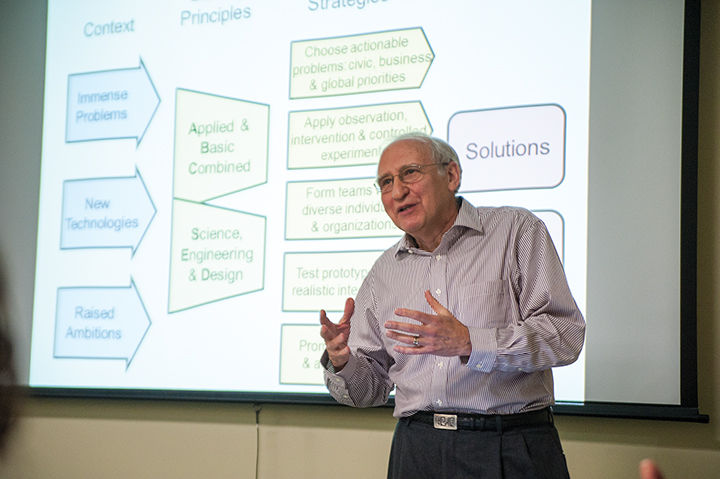
Ben Shneiderman gives a lecture on the changing field of research and the importance of collaboration in the internet age in the A.V. Williams Building on March 4, 2015.
After more than 30 years of studying computer science, Ben Shneiderman spent the last two working on a book about how to make studies like his more practical and approachable.
His answer is “The New ABCs of Research” – short phrases that highlight important scientific approaches, such as “Achieving Breakthrough Collaborations,” “Analyses Based on Creativity” and “Asking Bigger Questions.”
“I had to work to get that in there,” he said.
Shneiderman, a university computer science professor, shared his ideas with a group of about 20 faculty members in the A.V. Williams Building on Wednesday afternoon.
“I tried to understand the nature of research, and in doing that, I think I understand some of the principles I use, which were to work on real users on real problems with real data,” Shneiderman said during his hourlong talk. “Now that I see the evidence to support that, I can teach them to others.”
Using the “ABCs,” academics can make their research more practical, Shneiderman said, and apply hypothetical scientific theories to real-world situations.
Shneiderman, who invented the computer hyperlink in 1983, has depended on innovative, practical technology throughout his career, said Amitabh Varshney, University of Maryland Institute for Advanced Computer Studies director, as he introduced him.
Over the past two years, Shneiderman read 500 articles and more than 50 books while consistently revising and rewriting parts of his own book. He plans to complete it by this summer and publish it in the fall.
“This is sort of a very complicated book,” he said. “And I do want to send a message to my senior faculty that junior people and students are growing up in a different world and we need to change the way we think of research.”
Shneiderman said experiments are more successful when researchers work in teams. In his research, he found scientific papers drafted by groups were more successful than those drafted by individuals. Gone are the days of a mathematician sitting in his basement solving theoretical problems, he said.
To ensure the success of science in the future, Shneiderman said students should “Always Build Connections” by reaching out to other researchers via email and social media, creating online videos to garner interest and submitting work for publication.
“An early paper I submitted as a grad student was returned very promptly with the response, ‘The author should collect all copies and burn them,’” he said.
After revising it, however, it was published and went on to get cited about a thousand times, he said.
His research ideas are also inspired by his colleague Rita Colwell, a cell biology and molecular genetics professor who has studied cholera for more than 40 years.
The subtitle of his presentation, Shneiderman said jokingly, was “Why Rita Colwell is my hero,” and one of the “ABCs” of research was “Aspire to Be like Colwell.”
Varshney said Shneiderman’s approach could be a “driving application” in improving the scientific community.
“It’s about solving real problems with real data,” he said.
Jayanth Banavar, the computer, mathematical and natural sciences college dean, said Shneiderman gave “a brilliant talk.”
“[Some research] involves a lot of organization, and those types of problems cannot be solved without team-building or often a Nobel Prize winner or someone who has built a team and has had an idea that’s fantastic,” he said.
CORRECTION: Due to an editing error, Amitabh Varshney was incorrectly referred to as “she” when it should be “he.” This article has been updated.



